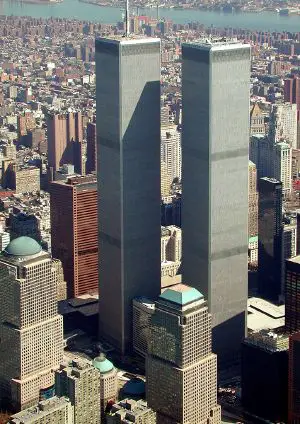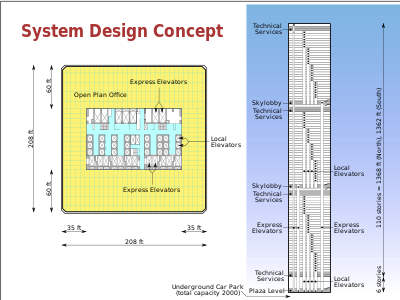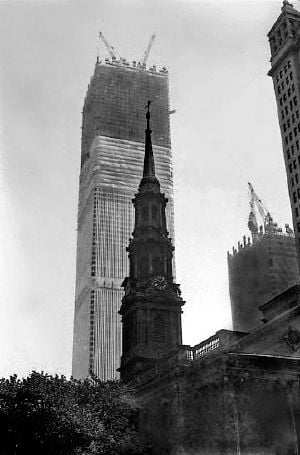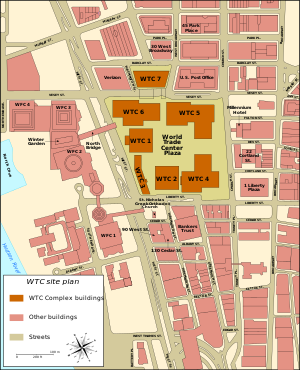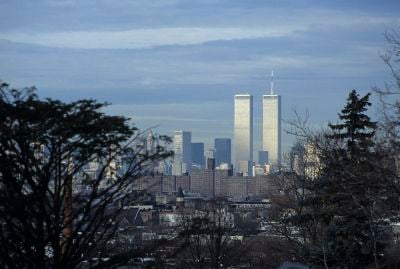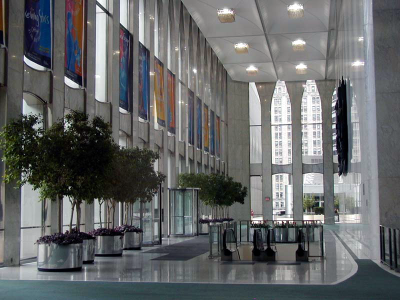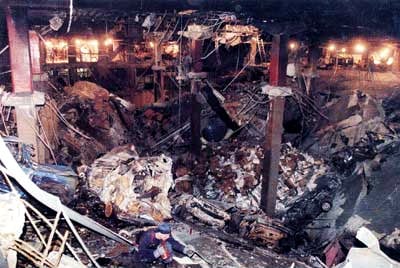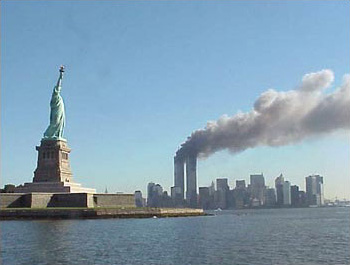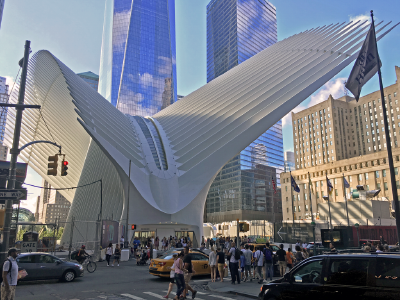World Trade Center
| World Trade Center | |
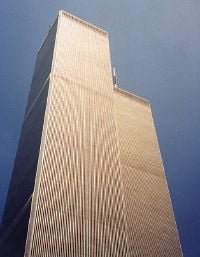
World Trade Center was the world's tallest building from 1972 to 1973.*
| |
| Preceded by | Empire State Building |
| Surpassed by | Sears Tower |
| Information | |
|---|---|
| Location | New York City, New York, USA (Lower Manhattan) |
| Status | Destroyed |
| Constructed | 1966-1973 |
| Destroyed | September 11, 2001 |
| Height | |
| Antenna/Spire | 1,727 feet [1] |
| Roof | 1,368 feet |
| Top floor | 1,355 feet |
| Technical details | |
| Floor count | 110 |
| Floor area | 8.6 million square feet (1 & 2) |
| Elevator count | 198 (1 & 2) |
| Companies | |
| Architect | Minoru Yamasaki, Emery Roth & Sons |
| Contractor | Tishman Realty & Construction Company |
| Owner | Port Authority of New York and New Jersey |
|
*Fully habitable, self-supported, from main entrance to highest structural or architectural top. | |
The World Trade Center in New York City (sometimes informally referred to as the WTC or the Twin Towers) was a complex of seven buildings, mostly designed by American architect Minoru Yamasaki and developed by the Port Authority of New York and New Jersey. It was destroyed on September 11, 2001, in an infamous terrorist attack.
The center was initiated in 1960 by a Lower Manhattan Association created and chaired by David Rockefeller, who had the original idea of building the Center, with strong backing from then New York governor, his brother, Nelson Rockefeller. The complex, located in the heart of New York City's downtown financial district, contained 13.4 million square feet of office space, almost four percent of Manhattan's entire office inventory.
Best known for its iconic, 110-story twin towers, the World Trade Center was beset by a fire on February 13, 1975, and a bombing on February 26, 1993. All of the original buildings in the complex were destroyed in the September 11, 2001 attacks, including the famous North and South Towers and 7 WTC, which collapsed; 3 WTC (the Marriott Hotel) which was crushed by the collapse of the main towers; and 4 WTC, 5 WTC, and 6 WTC were damaged beyond repair and later demolished. In addition, nearby St. Nicholas Greek Orthodox Church (not part of the complex) was destroyed by the collapse of 2 WTC.
The World Trade Center complex was rebuilt over a span of more than a decade. The site is being rebuilt with six new skyscrapers, while a memorial to those killed in the attacks and a new rapid transit hub have both opened. One World Trade Center, the tallest building in the United States, is the lead building for the new complex, reaching more than 100 stories upon its completion in November 2014.
Planning and construction
During the post-World War II period, the United States thrived economically, with increasing international trade. At the time, economic growth in New York City was concentrated in Midtown Manhattan, with Lower Manhattan left out. To help stimulate urban renewal, David Rockefeller, with support from his brother, New York Governor Nelson Rockefeller, suggested that the Port Authority should build a "world trade center" in Lower Manhattan.
Initial plans, made public in 1961, identified a site along the East River for the World Trade Center. Meanwhile, New Jersey's Hudson and Manhattan Railroad (H&M) was facing bankruptcy. Port Authority executive director, Austin J. Tobin agreed to take over control of the H&M Railroad, in exchange for support from New Jersey for the World Trade Center project. With this acquisition, the Port Authority would obtain the Hudson Terminal, and decrepit buildings located above the terminal in Lower Manhattan. The Port Authority decided to demolish these buildings, and use the site along the Hudson River for the World Trade Center.
The complex towers were designed by architect Minoru Yamasaki with Antonio Brittiochi and Emery Roth & Sons as associate architects. The World Trade Center was one of the most striking American implementations of the architectural ethic of Le Corbusier, as well as the seminal expression of Yamasaki's Gothic modernist tendencies.
Structural design
The World Trade Center included many structural engineering innovations in skyscraper design and construction. The towers were designed as framed tube structures, with columns grouped around the perimeter and within the core. The perimeter columns supported virtually all lateral loads, such as wind loads, and shared the gravity loads with the core columns. All columns were founded on bedrock, which unlike Midtown Manhattan, where the bedrock is shallow, is at 65 feet below the surface.
Perimeter columns
Above the seventh floor there were 59 perimeter columns along each face of the building. The perimeter columns had a square cross section, 14 inches on a side, and were constructed of welded steel plate. The thickness of the plates and grade of steel were varied over the height of the tower, ranging from 36 kilogram per square inch (ksi) to 100 ksi, with the steel strength and plate thickness decreasing with height. The perimeter columns supported virtually all lateral loads such as wind loads and shared the gravity loads with the core columns. The perimeter structure was constructed with extensive use of prefabricated modular pieces, which consisted of three columns, three stories tall, connected together by spandrel plates.
The spandrel plates were welded to the columns at the fabrication shop. The modular pieces were typically 52 inches deep, and extended for two full floors and half of two more floors. Adjacent modules were bolted together, with the splices occurring at mid-span of the columns and spandrels. The spandrel plates were located at each floor, and served to transmit shear flow between columns, thus allowing them to work together in resisting lateral loads. The joints between modules were staggered vertically, so the column splices between adjacent modules were not at the same floor.
Core
The building's core housed the elevator and utility shafts, restrooms, three stairwells, and other support spaces. The core in 1 WTC was oriented with the long axis east to west, while that of 2 WTC was oriented north to south. The core of each tower was a rectangular area 87 by 135 feet and contained 47 steel columns running from the bedrock to the top of the tower. The columns tapered with height, and consisted of welded box-sections at lower floors and rolled wide-flange sections at upper floors. All of the elevators and stairwells were located in the core.
Floor system
The large, column-free space between the perimeter and core was bridged by pre-fabricated, floor trusses. The floors supported their own weight, as well as live loads, provided lateral stability to the exterior walls, and distributed wind loads among the exterior walls. The floors consisted of 4-inch-thick, lightweight concrete slabs laid on a fluted-steel deck. A grid of lightweight bridging trusses and main trusses supported the floors. The trusses had a span of 60 feet in the long-span areas and 35 feet in the short span area. The trusses connected to the perimeter at alternate columns, and were therefore on six-foot, eight-inch centers. The top chords of the trusses were bolted to seats welded to the spandrels on the exterior side, and a channel welded to the core columns on the interior side. The floors were connected to the perimeter spandel plates with viscoelastic dampers, which reduced building structural vibration and were first utilized in the Twin World Trade Center Towers in New York in 1969, for wind induced vibrations. VE damping system in the Twin Towers is a double-layer shear damper using a 3M material, which is a rubber derivative, glued to steel plate and angle irons.[2] This helped reduce the amount of sway felt by building occupants. The trusses supported a 4-inch-thick, lightweight-concrete floor slab, with shear connections for composite action.
Hat trusses
Hat trusses (or "outrigger truss") located from the 107th floor to the top of the buildings were designed to support a tall communications antenna on top of each building. However, only WTC1 (north tower) actually had an antenna. The truss system consisted of six trusses along the long axis of core and four along the short axis. This truss system allowed some load redistribution between the perimeter and core columns and supported the transmission tower.
Design innovations
To solve the problem of wind sway or vibration in the construction of the towers, chief engineer Leslie Robertson took a then unusual approachâinstead of bracing the buildings corner-to-corner or using internal walls, the towers were essentially hollow steel tubes surrounding a strong central core. The 208-foot-wide facade was, in effect, a prefabricated steel lattice, with columns on 39-inch centers acting as wind bracing to resist all overturning forces; the central core took the majority of the gravity loads of the building. A very light, economical structure was built by keeping the wind bracing in the most efficient area, the outside surface of the building.
Thus, the forces were not transferred through the floor membrane to the core, as in most curtain-wall structures. The core supported the weight of the entire building and the outer shell containing 240 vertical steel columns, called Vierendeel trusses, around the outside of the building, which were bound to each other using ordinary steel trusses. In addition, 10,000 dampers were included in the structure. With a strong shell and core such as this, the exterior walls could be simply light steel and concrete. With the massive core and lightweight shell for structural integrity, Robertson created a tower that was extremely light for its size. This method of construction also meant that the twin towers had high load-bearing walls.
The buildings were also the second supertall buildings to use sky lobbies, after the John Hancock Center in Chicago. Skylobbies are floors where commuters can switch from an express elevator that goes only to the sky lobbies to a local elevator that goes to each floor in a section. The local elevators were stacked on top of each other, within the same elevator shaft. Located on the 44th and 78th floors of each tower, the sky lobbies enabled the elevators to be used efficiently while taking up a minimum of valuable office space. Altogether, the World Trade Center had 95 express and local elevators. This system was inspired by the New York City Subway system, whose lines include local stations where local trains stop and express stations where all trains stop.
The site of the World Trade Center was located on landfill, with the bedrock located 65 feet below. In order to construct the World Trade Center, it was necessary to build the "bathtub," with the slurry wall along the West Street side of the site, which serves the purpose of keeping water from the Hudson River out. The slurry method involves digging a trench, and as excavation proceeds, filling the space with a "slurry" mixture, comprised of bentonite which plugs holes and keeps water out. When the trench was dug out, a steel cage was inserted, with concrete poured in, forcing the "slurry" out. The "slurry" method was devised by Port Authority chief engineer, John M. Kyle, Jr.
Construction
Groundbreaking for the construction of the World Trade Center was on August 5, 1966. The construction was under the auspices of the semi-autonomous Port Authority of New York and New Jersey. Thirteen square blocks of low rise buildings in Radio Row, some of which pre-dated the American Civil War, were razed to clear the site for construction.
The excavation of the foundations of the WTC complex, known as the Bathtub, was particularly complicated since there were two subway tubes nearby needing protection without service interruption. A six-level basement was built in the foundations. The excavation of about 1 million cubic yards of earth and rock created a $90-million, real-estate asset for the project owner, the Port Authority of New York and New Jersey, which helped offset the enormous loss in revenues which came from the tax breaks given to the Trade Center itself. The soil was used to create 23 acres of landfill in the Hudson River next to the World Trade Center site, which became the site of Battery Park City, which is still under development.
In 1970, construction was completed on One World Trade Center, with its first tenants moving into the building in December, 1970. Tenants first moved into Two World Trade Center in January 1972. The ribbon-cutting ceremony was on April 4, 1973. When the World Trade Center twin towers were completed, the total costs to the Port Authority had reached $900 million.
The complex
The Twin Towers
Ultimately the complex came to consist of seven buildings, but its most notable features were the main twin towers. Each of the WTC towers had 110 stories. 1 WTC (the North Tower, which featured a massive 360-foot-high, TV antenna added in 1978) stood 1,368 feet high, and 2 WTC (the South Tower, which contained the observation deck) was 1,362 feet high. The length and breadth of the towers were 208 feet by 208 feet. Although only Tower 1 featured an antenna, the structure of each building was designed to carry a broadcast mast, and in the basement of the complex, The Mall at the World Trade Center was Manhattan's largest mall until September 11th, 2001.
When completed in 1972, 1 WTC became the tallest building on Earth, unseating the Empire State Building after a 40-year reign. 2 WTC became the second tallest building in the world when completed in 1973. As the building neared completion, work had already begun on Chicago's Sears Tower, which ultimately reached 1,450 feet.
Of the 110 stories, eight were set aside for technical services. All the remaining floors were free for open-plan offices. Each floor of the towers had 40,000 square feet of space for occupancy. Each tower had 3.8 million square feet of office space. Altogether the entire complex of seven buildings had 11.2-million square feet of space.
During the 1990s, approximately 500 companies had offices in the complex, including major financial companies such as Morgan Stanley, Aon Corporation, Salomon Brothers, as well as the Port Authority itself. Electrical service to the towers was supplied by Consolidated Edison (ConEd) at 13,800 volts. This service passed through the World Trade Center Primary Distribution Center (PDC) and sent up through the core of the building to electrical substations located on the mechanical floors. The substations "stepped" the 13,800 primary voltage down to 480/277 volt secondary power and further to 120/208 volt general power and lighting service. The complex also was served by emergency generators located in the sublevels of the towers and on the roof of 5 WTC.
The 110th Floor of 1 WTC (North Tower) housed commercial and public service radio & television transmission equipment. The roof of 1 WTC contained a vast array of transmission antennas including the center antenna mast rebuilt in 1999 by Dielectric Inc. to accommodate DTV. The mast contained the television signals for almost all NYC television broadcasters. Access to the roof was controlled from the WTC Operations Control Center (OCC) located in the B1 level of 2 WTC.
The World Trade Center complex was protected by an extensive fire detection and voice evacuation paging system upgraded after the 1993 bombing. Fire Command Stations, staffed by Fire Safety Directors were located in the lobbies of each building and the Operations Control Center (OCC) monitored these systems.
Observation deck and Windows on the World
Although the majority of space in the World Trade Center complex was off-limits to the general public, 2 WTC (South Tower) featured a public observation area aptly named "Top Of The World." When visiting the observation deck, visitors would first pass through security checks added after the 1993 World Trade Center bombing. Next, visitors were whisked to the 107th floor indoor observatory and greeted with a 360-degree view of the New York City skyline, and exhibitions including a three-dimensional scale model of Manhattan and a simulated helicopter ride around the city. Weather permitting, visitors could take two short escalator rides up from the 107th floor and visit what was the world's highest outdoor viewing platform. At a height of 1,377 feet, visitors were able to take in a view of the North Tower and New York City unlike any other. On a clear day, it was claimed that visitors could see up to 45 miles in any given direction. An anti-suicide fence was placed on the roof itself, with the viewing platform set back and elevated above it, requiring only an ordinary railing and leaving the view unobstructed.
The North Tower (1 WTC) had a restaurant on the 107th floor called Windows on the World, which was an elegant eatery known as a place for big celebrations, such as weddings. In its last full year of operation, Windows on the World reported revenues of $37.5 million, making it the highest-grossing restaurant in the United States.
The other buildings
Five smaller buildings stood around the 16-acre block. One was the 22-floor Vista Hotel (3 WTC), later a Marriott Hotel, at the southwest corner of the site. It was crushed between the two towers when they collapsed. Three low-rise buildings (4 WTC, 5 WTC, and 6 WTC) in the same basic design as the main towers also stood around the plaza. 6 World Trade Center, at the northwest corner, housed the United States Customs Service and the U.S. Commodities Exchange. 5 World Trade Center was located at the northeast corner, above the PATH train station, and 4 World Trade Center was at the southeast corner. In 1987, a 46-floor office building called 7 WTC was built north of the block. Beneath the World Trade Center complex was an underground shopping mall, which in turn had connections to various mass transit facilities, including the New York City subway system and the Port Authority's own trains connecting Manhattan to Jersey City.
One of the world's largest gold depositories was stored underneath the World Trade Center, owned by a group of commercial banks. The 1993 bomb detonated close to the vault, but it withstood the explosion, as did the towers. Seven weeks after the September 11th attacks, $230 million in precious metals were removed from basement vaults of 4 WTC, which included 3,800, 100-Troy-ounce registered gold bars and 30,000 1,000-ounce silver bars.
Architectural criticism
Although the towers became an undeniable icon of New York City, they were not without flaws and were handicapped in many ways. Initially conceived, (as the name suggests) as a complex dedicated to companies and organizations directly taking part in "world trade," they at first failed to attract the expected clientĂšle. During the early years, various governmental organizations became key tenants of the World Trade Center, including the State of New York. It was not until the 1980s that the city's perilous financial state eased, after which an increasing number of private companiesâmostly financial firms tied to Wall Streetâbecame tenants.
Moreover, the trade center's "superblock," which replaced a more traditional, dense neighborhood, was regarded by some critics as an inhospitable environment that disrupted the complicated traffic network typical of Manhattan. For example, in his book The Pentagon of Power, the technical historian Lewis Mumford denounced the center as an "example of the purposeless giantism and technological exhibitionism that are now eviscerating the living tissue of every great city."[3] On the other hand, Mr. Yamasaki saw the expanse as a focal point of serenity amidst the chaos of the city. The twin tower's narrow office windows, only 18 inches wide, were also disliked by many for impairing the view from the buildings. This design element reflected on Yamasaki's fear of heights and desire to make building occupants secure with narrow windows.
For many years, the outdoor five-acre Austin J. Tobin Plaza, also known as the World Trade Center Plaza, was unpopular because its appearance was considered barren and unwelcoming. However, in later years it became a popular center for outdoor concerts and other activities. In 1999, the plaza re-opened after undergoing $12 million renovations, which involved replacing marble pavers with gray and pink granite stones, adding new benches, planters, new restaurants and food kiosks, and outdoor dining areas.
Life of the World Trade Center
On any given day, approximately 50,000 people worked in the towers, with another 200,000 passing through as visitors. The complex was so large that it had its own zip code, 10048. The towers offered spectacular views from the observation deck and the Windows on the World restaurant (located on top of the North Tower). The trade center had its many admirers, particularly visitors. For those who deemed it cold and sterile, there were just as many who appreciated its sheer grandeur; some even took advantage of it. French high-wire, acrobatic performer Philippe Petit walked between the towers on a tightrope in 1974, and Brooklyn toymaker George Willig scaled the south tower in 1977. The Twin Towers became known worldwide, appearing in movies, TV shows, postcards, merchandise, magazines, and much more. The twin towers became a New York icon, not unlike the Empire State Building, or Statue of Liberty.
February 13, 1975 fire
On February 13, 1975, the WTC North Tower was beset by a fire which spread over nearly half of the eleventh floor. The fire spread to other floors through openings in the floor slabs which were used to carry phone wires. The fires on other floors were extinguished almost immediately, and the main fire was put out in a few hours. This event led to the installation of a sprinkler system in both towers. Other than the damage caused by the fire, a few floors below suffered water damage from the extinguishing of the fires above.
Bombing of February 26, 1993
On February 26, 1993 at 12:17 PM, a Ryder truck filled with 1,500 pounds of explosives was planted by Islamic terrorist Ramzi Yousef and detonated in the underground garage of the North Tower, opening a 100-foot hole through five sublevels of concrete leaving 50,000 workers and visitors gasping for air in the shafts of the 110-story towers.
Many people inside the North Tower were forced to walk down darkened stairwells which contained no emergency lighting, some taking two hours or more to reach safety. As the Port Authority was a bi-state agency, the towers were exempt from New York City building codes. Subsequent to the bombing, The Port Authority installed emergency lighting in the stairwells. It is believed that this lighting saved many lives during the events of September 11, 2001.
In 1997 and 1998, six Islamic extremists were convicted and sentenced to life in prison for their roles in the bombing. According to a presiding judge, the conspirators' chief aim at the time of the attack was to de-stabilize the north tower and send it crashing into the south tower, toppling both landmarks.
A granite memorial fountain honoring the six people killed in the bombing was designed by Elyn Zimmerman and dedicated in 1995 on Austin J. Tobin Plaza, directly above the site of the explosion. It contained the names of the six people who perished in the attack as well as an inscription that read:
On February 26, 1993, a bomb set by terrorists exploded below this site. This horrible act of violence killed innocent people, injured thousands, and made victims of us all.
The fountain was destroyed during the September 11, 2001 attacks. A recovered fragment from the 1993 bombing memorial with the word "John" is being used as the centerpiece of a new memorial honoring the victims of the 2001 attack.
Privatization
In 1998, plans were approved by the Port Authority to privatize the World Trade Center. In 2001, the Port Authority sought to lease the World Trade Center to a private entity. Bids for the lease came from Vornado Realty Trust, a joint bid between Brookfield Properties and Boston Properties, and a joint bid by Silverstein Properties and The Westfield Group. By privatizing the World Trade Center, it would be added to the city's tax rolls. The lease was also intended to raise funds for other Port Authority projects.
On February 15, 2001, the Port Authority announced that Vornado Trust Realty had won the lease for the World Trade Center, paying $3.25 billion for the 99-year lease. Silverstein was outbid by $50 million by Vornado Realty. However, Vornado later withdrew and Silverstein's bid for the lease to the World Trade Center was accepted on July 24, 2001. The land was then privately owned.
September 11, 2001
On September 11, 2001, at 8:46 a.m., Al Qaeda suicide hijackers crashed American Airlines Flight 11 into the northern facade of the North Tower. Seventeen minutes later, at 9:03 a.m., a second team of hijackers crashed United Airlines Flight 175 into the South Tower, which collapsed at 9:59 a.m. At 10:28 a.m., the North Tower collapsed. At 5:20 p.m., 7 World Trade Center collapsed. The four remaining buildings in the WTC plaza sustained heavy damage from debris, and were ultimately demolished.
At the time of the incident, media reports suggested that tens of thousands might have been killed in the massacre, as on any given day upwards of 100,000 people could be inside the towers. Ultimately, 2,749 death certificates were filed relating to the 9/11 attacks, as of February 2005. Of these, 1,588 (58 percent) were forensically identified from recovered physical remains.
For the following eight and a half months, the World Trade Center site cleanup and recovery continued 24 hours a day and involved thousands of workers. The massive pile of debris smoked and smoldered for 99 days.
Morgan Stanley was the largest tenant in the World Trade Center, with approximately 2,500 employees in the South Tower and 1,000 in the North Tower.
Rebuilding the World Trade Center
Over the following years, plans were created for the reconstruction of the World Trade Center. The Lower Manhattan Development Corporation (LMDC), established in November 2001 to oversee the rebuilding process,[4] organized competitions to select a site plan and memorial design. Memory Foundations, designed by Daniel Libeskind, was selected as the master plan.[5] However, substantial changes were made to the design. One World Trade Center (previously coined the "Freedom Tower" by Governor Pataki) is the centerpiece of Libeskind's design.
The first new building to be completed was 7Â WTC, which opened in May 2006. The memorial section of the National September 11 Memorial & Museum opened on September 11, 2011 and the museum opened in May 2014. The September 11 Museum opened to victims' families on April 15, 2014, and to the general public six days later. One WTC opened on November 3, 2014. One World Trade Center opened for business on November 3, 2014, with its observatory opening on May 29, 2015. The Oculus, the World Trade Center Transportation Hub was completed in 2016. 3 World Trade Center was completed in 2018, leaving 2 and 5 World Trade Center as the last two remaining unbuilt towers in the WTC complex; the construction of St. Nicholas Greek Orthodox Church also remains uncompleted.[6]
Notes
- â Skyscraper Page, One World Trade Center. Retrieved September 30, 2022.
- â Design Community, Viscoelastic dampers. Retrieved September 30, 2022.
- â Lewis Mumford, The Pentagon of Power (Harcourt, Brace and Jovanovich, Inc., 1974).
- â Richard PĂ©rez-Peña, A Nation Challenged: Downtown; State Plans Rebuilding Agency, Perhaps Led by Giuliani The New York Times, November 3, 2001. Retrieved September 30, 2022.
- â Lower Manhattan Development Corporation, The Plan for Lower Manhattan Retrieved September 30, 2022.
- â Sixteen Acres, Eighteen Years: The Status of the WTC Complex NYC Urbanism. Retrieved September 30, 2022.
ReferencesISBN links support NWE through referral fees
- Gillespie, Angus K. Twin Towers: The Life of New York City's World Trade Center. Rutgers University Press, 1999. ISBN 978-0813527420
- Harris, Bill. The World Trade Center: A Tribute. Courage Books, 2001. ISBN 978-0762413157
- Koch III, Karl. Men of Steel: The Story of the Family that Built the World Trade Center. Three Rivers Press, 2003. ISBN 978-1400049509
- Mumford, Lewis. The Pentagon of Power. Harcourt, Brace and Jovanovich, Inc., 1974. ASIN 0156716100
- Smith, Dennis. Report from Ground Zero: The Story of the Rescue Efforts at World Trade Center. Viking Adult, 2002. ISBN 978-0670031160
External links
All links retrieved May 19, 2023.
- World Trade Center official site
- World Trade Center Webcams
- One World Observatory
- 9/11 Memorial & Museum
Credits
New World Encyclopedia writers and editors rewrote and completed the Wikipedia article in accordance with New World Encyclopedia standards. This article abides by terms of the Creative Commons CC-by-sa 3.0 License (CC-by-sa), which may be used and disseminated with proper attribution. Credit is due under the terms of this license that can reference both the New World Encyclopedia contributors and the selfless volunteer contributors of the Wikimedia Foundation. To cite this article click here for a list of acceptable citing formats.The history of earlier contributions by wikipedians is accessible to researchers here:
The history of this article since it was imported to New World Encyclopedia:
Note: Some restrictions may apply to use of individual images which are separately licensed.
